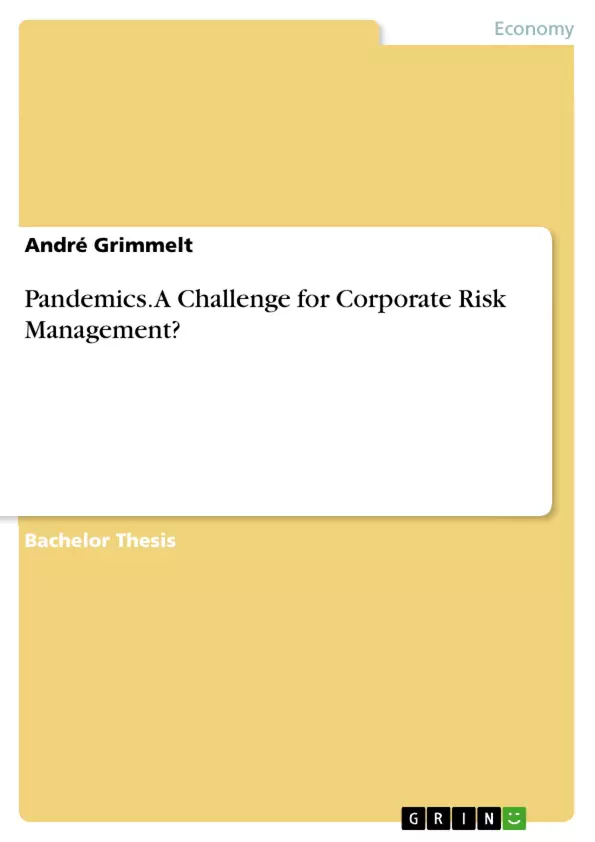The paper deals with the economic impact of possible pandemics and draws conclusions for the risk management of individual companies. Against the background of historical examples, the emergence of pandemics and their possible effects are explained. On the basis of the WHO classification, the current risk situation is discussed and the possible economic effects are examined. The consequences on the supply and demand side are considered and the short-, medium- and long-term effects of a pandemic are also dealt with. Furthermore, the exposure of various industries to such an emergency is analysed.
The possible consequences for the individual company are also explained. Furthermore, disruptions in business operations, transport or infrastructure and changes in the economic environment of a company are described in more detail. The work also describes the task, the goal and the possibilities of operational pandemic planning.
Inhaltsverzeichnis (Table of Contents)
- Introduction
- Pandemics
- Definition of the term "pandemic"
- Emergence of pandemics
- Impact of previous pandemic cases
- Spanish influenza
- Asian flu and Hong Kong flu
- SARS
- Scenarios of a future pandemic
- Assessment of the current danger situation
- Summary pandemic
- Economic effects of a pandemic
- Impact of a pandemic on the economy
- Economic sectors particularly affected by a pandemic
- Summary: Economic impact of a pandemic
- Impact of a pandemic on the individual company
- Effects due to the illness of employees and their family members
- Effects due to disruptions in the supply system
- Effects due to the change in the economic environment
- Summary of the impact of a pandemic on individual companies
- Pandemic a challenge for risk management?
- Definition of "risk"
- Definition of "risk management"
- Risk management objectives
- Costs and benefits of operational preparation for the pandemic
- Implementation of pandemic planning as part of the Risk management in the company
- Summary Risk management against the backdrop of a pandemic
- Pandemic planning as part of risk management
- Operational pandemic planning in the context of risk management
- Approaches to the implementation of operational pandemic planning
- Task of operational pandemic planning
- Pandemic planning
- Neuraminidase inhibitors as part of pandemic planning
- Summary: Pandemic planning as part of risk managements
- Conclusion
Zielsetzung und Themenschwerpunkte (Objectives and Key Themes)
This work aims to provide comprehensive answers to key questions regarding the risks associated with a pandemic for companies. It delves into the necessity of implementing risk prevention measures against pandemic threats and aims to guide companies towards effective pandemic planning.
- The emergence of pandemics and their effects
- The economic impact of a pandemic on both the demand and supply sides
- The impact of a pandemic on individual companies, including employee health, supply chain disruptions, and economic environment changes
- The role of risk management in mitigating pandemic risks
- The implementation of pandemic planning as a crucial aspect of risk management
Zusammenfassung der Kapitel (Chapter Summaries)
The second chapter delves into the emergence of pandemics, examining past experiences with pandemic cases and assessing the risk for future outbreaks. It culminates with an assessment of the current pandemic danger situation.
The third chapter elaborates on the economic effects of a pandemic, analyzing the impact on both demand and supply sides. It explores the short-, medium-, and long-term economic consequences of a pandemic and examines the differential effects on various industries.
The fourth chapter explores the specific impact of a pandemic on individual companies. It examines the consequences of employee illness, supply chain disruptions, and changes in the economic environment.
The fifth chapter delves into the concept of risk and risk management, outlining the objectives and benefits of implementing risk management strategies. It addresses the necessity of specific planning for pandemic risks within the company.
The sixth chapter focuses on pandemic planning as an integral part of risk management. It outlines the tasks and approaches for implementing operational pandemic planning, including the use of neuraminidase inhibitors as a potential preventative measure.
Schlüsselwörter (Keywords)
The key focus areas of this work include pandemics, economic effects, risk management, pandemic planning, neuraminidase inhibitors, and corporate risk assessment. The work explores the importance of proactive risk management strategies in the face of pandemic threats and aims to guide companies toward effective pandemic preparedness.
- Citation du texte
- André Grimmelt (Auteur), 2008, Pandemics. A Challenge for Corporate Risk Management?, Munich, GRIN Verlag, https://www.grin.com/document/1162308



